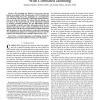Free Online Productivity Tools
i2Speak
i2Symbol
i2OCR
iTex2Img
iWeb2Print
iWeb2Shot
i2Type
iPdf2Split
iPdf2Merge
i2Bopomofo
i2Arabic
i2Style
i2Image
i2PDF
iLatex2Rtf
Sci2ools
CORR
2006
Springer
2006
Springer
Mutual Information Games in Multi-user Channels with Correlated Jamming
We investigate the behavior of two users and one jammer in an additive white Gaussian noise (AWGN) channel with and without fading when they participate in a noncooperative zero-sum game, with the channel's input/output mutual information as the objective function. We assume that the jammer can eavesdrop on the channel and can use the information obtained to perform correlated jamming. We also differentiate between the availability of perfect and noisy information about the user signals at the jammer. Under various assumptions on the channel characteristics, and the extent of information available at the users and the jammer, we show the existence, or otherwise nonexistence of a simultaneously optimal set of strategies for the users and the jammer, and characterize those strategies whenever they exist.
Additive White Gaussian Noise | CORR 2006 | Education | Information | Noncooperative Zero-sum Game |
| Added | 11 Dec 2010 |
| Updated | 11 Dec 2010 |
| Type | Journal |
| Year | 2006 |
| Where | CORR |
| Authors | Shabnam Shafiee, Sennur Ulukus |
Comments (0)

